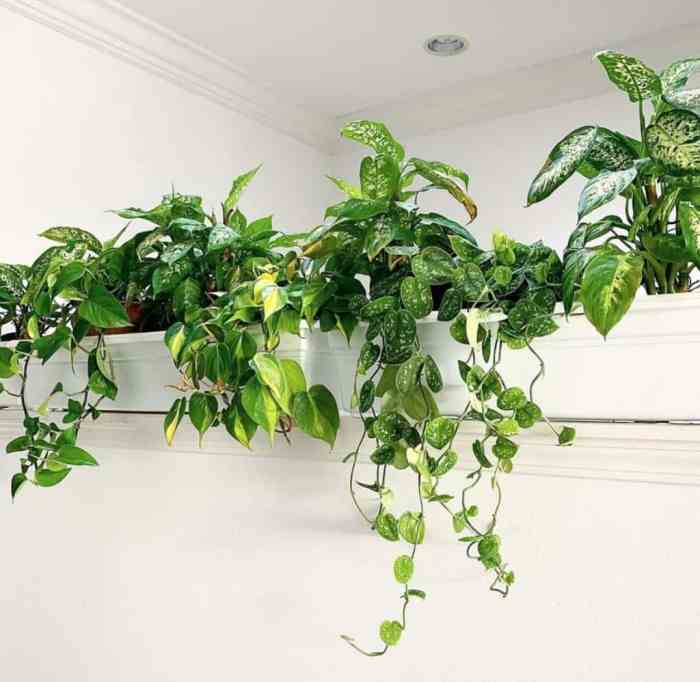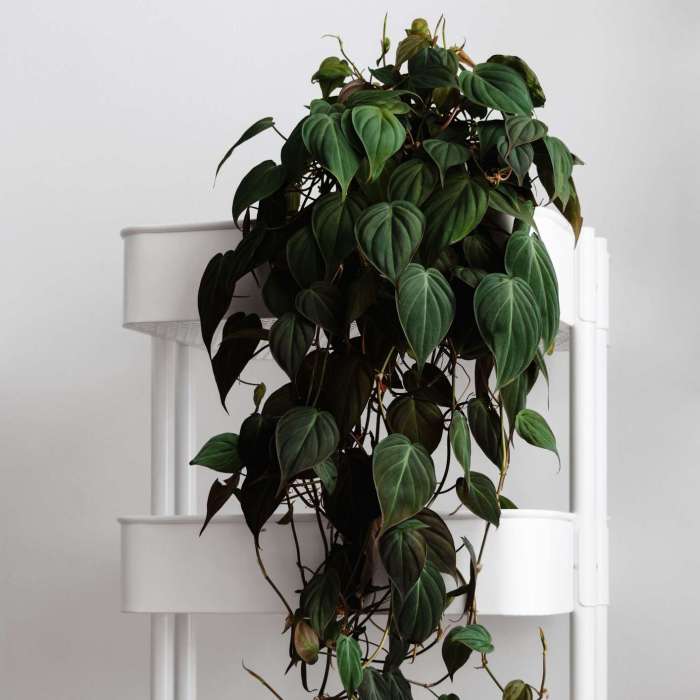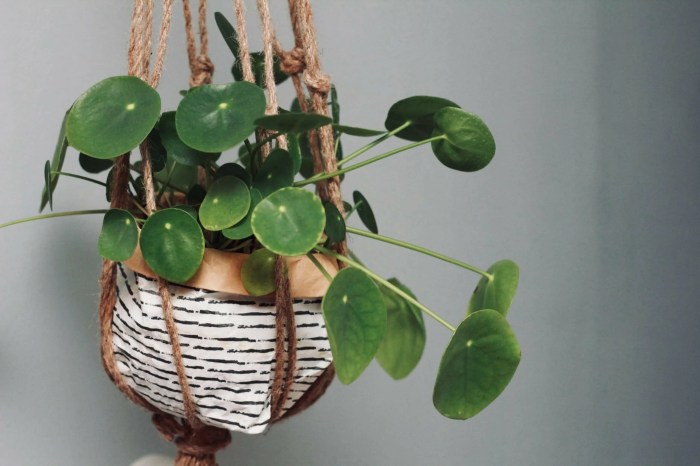Easy to care for indoor hanging plants – With easy-to-care indoor hanging plants taking center stage, this article delves into the fascinating world of greenery that enhances your home’s ambiance effortlessly. Discover the benefits, care tips, and inspiring ideas to transform your living space into a botanical oasis.
From air purification to stress reduction, indoor hanging plants offer a myriad of advantages that will elevate your well-being. Join us as we explore the secrets to keeping these verdant companions thriving, ensuring they add a touch of nature to your daily life.
Popular Easy-to-Care Indoor Hanging Plants

Hanging plants add a touch of greenery and life to any room. They are a great way to bring the outdoors in and can help to purify the air. But not all hanging plants are created equal. Some are more difficult to care for than others.
If you are looking for a low-maintenance hanging plant, here are a few of the most popular and easy-to-care-for options:
Spider Plant
- Botanical name: Chlorophytum comosum
- Common name: Spider plant
- Unique features: Spider plants are known for their long, trailing leaves that produce baby spider plants at the ends. They are very easy to care for and can tolerate a wide range of light conditions.
Pothos
- Botanical name: Epipremnum aureum
- Common name: Pothos
- Unique features: Pothos is a fast-growing vine with heart-shaped leaves. It is very tolerant of neglect and can even grow in low-light conditions.
String of Pearls, Easy to care for indoor hanging plants
- Botanical name: Senecio rowleyanus
- Common name: String of pearls
- Unique features: String of pearls is a succulent with long, trailing stems that are covered in small, bead-like leaves. It is a very easy-to-care-for plant that does not require a lot of water.
Burro’s Tail
- Botanical name: Sedum morganianum
- Common name: Burro’s tail
- Unique features: Burro’s tail is a succulent with long, trailing stems that are covered in plump, finger-like leaves. It is a very easy-to-care-for plant that does not require a lot of water.
Benefits of Indoor Hanging Plants

Adding indoor hanging plants to your home can bring a host of benefits, both aesthetic and practical. These plants not only enhance the beauty of your space but also contribute to your well-being.
One of the primary benefits of indoor hanging plants is their ability to improve air quality. Studies have shown that certain plants, such as spider plants and peace lilies, can remove harmful toxins from the air, including benzene, formaldehyde, and trichloroethylene.
For those seeking low-maintenance greenery indoors, easy to care for indoor hanging plants offer a convenient solution. These plants thrive in hanging baskets or planters, adding a touch of elegance to any room. From trailing vines to lush ferns, there’s a wide variety of easiest hanging house plants that require minimal attention, making them ideal for busy individuals or those with limited gardening experience.
With their ability to purify the air and create a serene ambiance, easy to care for indoor hanging plants are a must-have for any home.
These toxins are commonly found in household products, such as cleaning supplies and building materials, and can contribute to health problems such as headaches, nausea, and respiratory issues.
Among the most convenient indoor hanging plants, trailing varieties offer an effortless way to add a touch of greenery to your home. From the classic Pothos to the cascading String of Pearls, these easiest trailing plants require minimal care and thrive in a variety of lighting conditions, making them perfect for busy plant enthusiasts or those new to indoor gardening.
Reduces Stress and Boosts Mood
Indoor hanging plants have also been shown to reduce stress and boost mood. Studies have found that spending time in nature or viewing plants can lower cortisol levels, the hormone associated with stress. Additionally, the presence of plants in a room can create a sense of calm and tranquility, promoting relaxation and reducing feelings of anxiety.
For those seeking low-maintenance greenery, easy to care for indoor hanging plants offer a delightful solution. Whether cascading from a shelf or adorning a windowsill, these plants add a touch of nature to any space. Among the most manageable options are easy care trailing plants , which boast long, flowing stems that drape gracefully over containers.
By incorporating both hanging and trailing plants into your indoor decor, you can create a lush and inviting atmosphere that requires minimal effort to maintain.
Improves Sleep Quality
Certain indoor hanging plants, such as lavender and jasmine, have been found to improve sleep quality. These plants release scents that have calming and sedative effects, helping you to fall asleep more easily and sleep more soundly.
Care and Maintenance for Indoor Hanging Plants
Indoor hanging plants not only enhance the aesthetics of your space but also offer numerous benefits. To ensure their health and longevity, proper care and maintenance are crucial. Here’s a comprehensive guide to caring for your indoor hanging plants:
Watering
Watering is a delicate balance. Overwatering can lead to root rot, while underwatering can stunt growth. The ideal watering schedule depends on the plant species, pot size, and environmental conditions. As a general rule, water when the top inch of soil feels dry to the touch.
Fertilizing
Fertilizing provides essential nutrients for plant growth. Use a balanced liquid fertilizer diluted to half strength and fertilize monthly during the growing season (spring and summer). Avoid over-fertilizing, as this can burn the roots.
Pruning
Regular pruning promotes healthy growth and prevents leggy plants. Remove dead or damaged leaves and stems, and trim back overgrown stems to encourage bushier growth. Prune lightly in spring or summer, when the plant is actively growing.
Pest Control
Pests can be a nuisance for indoor hanging plants. Regularly inspect your plants for signs of infestation, such as aphids, mealybugs, or spider mites. Treat infestations promptly using insecticidal soap or neem oil.
Choosing the Right Location and Lighting
Selecting the right location and providing optimal lighting conditions are crucial for the well-being of your hanging plants. Choose a spot with bright, indirect light and avoid placing plants in direct sunlight, which can scorch the leaves.
Troubleshooting Common Problems: Easy To Care For Indoor Hanging Plants
Indoor hanging plants can occasionally encounter issues, but these can be easily resolved with proper care and attention. Understanding the causes and symptoms of common problems is crucial for maintaining healthy and thriving plants.
Pest Infestation
- Symptoms:Visible pests, such as aphids, mealybugs, or spider mites, on leaves or stems; discolored or deformed leaves; sticky residue on plant surfaces.
- Causes:Overwatering, poor ventilation, or introducing infested plants.
- Solutions:
- Isolating the affected plant to prevent spreading.
- Using insecticidal soap or neem oil to kill pests.
- Improving air circulation and avoiding overwatering.
Leaf Discoloration
- Symptoms:Yellowing, browning, or wilting leaves; stunted growth.
- Causes:Overwatering, underwatering, nutrient deficiency, or excessive sunlight.
- Solutions:
- Adjusting watering frequency based on the plant’s needs.
- Fertilizing the plant regularly with a balanced fertilizer.
- Providing adequate light but avoiding direct sunlight.
Root Rot
- Symptoms:Soggy or mushy roots; wilting leaves; yellowing or browning of foliage.
- Causes:Overwatering or poor drainage.
- Solutions:
- Repotting the plant in fresh, well-draining soil.
- Trimming away any damaged or rotten roots.
- Adjusting watering practices to avoid overwatering.
Design Ideas and Inspiration

Incorporating indoor hanging plants into home decor offers a touch of greenery and freshness. These plants can transform a space, adding life and vibrancy. Whether you’re a seasoned plant enthusiast or a novice, there are numerous creative ways to display your indoor hanging plants.
With their ability to thrive in low light and humidity, easy to care for indoor hanging plants are a great way to add life and color to your home. For more information on the best indoor hanging plants, visit Hanging Plants Indoor , which provides comprehensive guides on plant care, varieties, and design inspiration.
Easy to care for indoor hanging plants can purify the air, boost your mood, and add a touch of nature to any room.
One popular design idea is to create a vertical garden. This involves hanging multiple plants at different heights, creating a lush and eye-catching display. You can use a variety of plants with contrasting colors and textures to add visual interest.
Another option is to hang plants from the ceiling, using macrame or other materials. This creates a cascading effect that can draw attention to a specific area or create a focal point.
Hanging Methods
There are several methods for hanging indoor plants. You can use hooks or nails to attach plants to the ceiling or walls. Alternatively, you can use macrame or other materials to create unique and decorative hangers. Macrame is a type of knotting that can be used to create intricate and beautiful plant hangers.
It adds a bohemian touch to any space and can be customized to suit your personal style.
Table of Hanging Plant Design Ideas
|
- *Design Idea |
- *Image |
- *Description |
|—|—|—||*Vertical Garden | [Image of a vertical garden with hanging plants] | Create a lush and eye-catching display by hanging multiple plants at different heights. ||*Ceiling-Mounted Plants | [Image of plants hanging from the ceiling] | Hang plants from the ceiling using macrame or other materials to create a cascading effect.
||*Macrame Plant Hangers | [Image of a macrame plant hanger] | Add a bohemian touch to your space with macrame plant hangers. These hangers can be customized to suit your personal style. ||*Wall-Mounted Plants | [Image of plants mounted on a wall] | Use hooks or nails to attach plants to walls, creating a unique and space-saving display.
|
Outcome Summary

Incorporating easy-to-care indoor hanging plants into your home decor is not merely a trend but an investment in a healthier, more vibrant living environment. By following the expert guidance provided in this article, you can create a flourishing indoor garden that brings joy, tranquility, and a touch of the outdoors inside.
FAQ Overview
How often should I water my indoor hanging plants?
Watering frequency depends on factors like plant type, pot size, and humidity. Check the soil regularly and water when the top inch feels dry to the touch.
What are some common pests that affect indoor hanging plants?
Common pests include aphids, mealybugs, and spider mites. Inspect your plants regularly and treat infestations promptly with insecticidal soap or neem oil.
Can I hang plants in low-light areas?
Some plants, such as pothos and ZZ plants, tolerate low light conditions. Choose plants that suit the lighting conditions in your home.